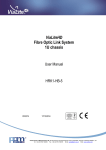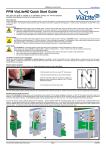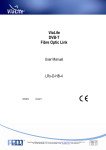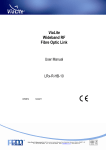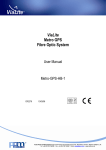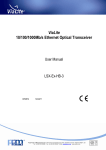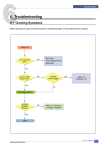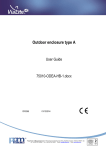Download ViaLiteHD Summary alarm module
Transcript
ViaLiteHD Summary alarm module User Guide HRC-2-HB-4 CR3384 02/09/2015 Pulse Power & Measurement Ltd, 65 Shrivenham Hundred Business Park, Watchfield, Swindon, Wiltshire SN68TY, UK Tel +44 (0)1793 784389 Fax +44 (0)1793 784391 Email [email protected] Web www.vialite.com PPM LTD 2015 Instrument Care and Safety Information Please read the whole of this section before using your ViaLiteHD product. It contains important safety information and will enable you to get the most out of your Fibre Optic Link. Electrical Safety The ViaLiteHD rack chassis is a Safety Class 1 product (having metal chassis directly connected to earth via the power supply cable). When operating the equipment note the following precautions: Hazardous voltages exist within the equipment. There are no user serviceable parts inside; the covers should only be removed by a qualified technician. There are no user replaceable fuses in the rack chassis mounted equipment. Replacement should only be carried out by a PPM technician. The rack chassis earth stud SHOULD be connected to the safety earth. When using a 2 pin power supply cable the rack chassis earth stud MUST be connected to the safety earth. The ViaLiteHD Power Supply Modules do not have an isolating switch on the mains voltage inlet. For this reason, the ViaLiteHD Rack Chassis must be installed within easy reach of a clearly labelled dual pole mains isolation switch, which supplies the equipment. ESD Precautions The ViaLiteHD RF Fibre Optic Link is equipped with high frequency active electronics, without the correct handing they will be susceptible to damage. Precautions for handling electro-static sensitive devices should be observed when handling all ViaLiteHD modules. Technicians should ensure that they use effective personal grounding (i.e. ESD wrist strap etc.) when servicing the equipment. Any equipment or tools used should be grounded to prevent static charge build-up. Good practice should be observed at all times for reference see relevant standards. EN 61340-5-1, “Protection of Electronic Devices from Electrostatic Phenomena – General Requirements” Optical Safety The ViaLiteHD RF Fibre Optic Transmitters, Dual Transmitters and Transceivers contain optical sources (usually laser diodes) operating at nominal wavelengths of 1270nm to 1610nm. These devices are rated as EN60825-1:2007 as CLASS 1 radiation emitting devices. A class 1 laser is safe under all conditions of normal use. When operating the equipment note the following precautions: Never look into the end of an optical fibre directly or by reflection either with the naked eye or through an optical instrument. Never leave equipment with radiating bare fibres – always cap the connectors. Do not remove equipment external covers when operating. Hot surface The ViaLiteHD Summary alarm module may have hot surfaces when operating under fulll load. The hot surfaces are not accessible when fitted in an approved rack chassis installation. Suitable precaution should be taken when handling this device. Allow to cool for 10 minutes Do not touch metallic surfaces or printed circuit board when hot. When handling, hold front panel and handle only. 2 PPM LTD 2015 TABLE OF CONTENTS 1 INTRODUCTION................................................................................................................................................................................. 4 1.1 Internal architecture 4 1.2 Typical deployment 5 1.3 ViaLiteHD and ViaLite Classic compatibility 5 2 SUMMARY ALARM MODULE, PHYSICAL INTERFACES .................................................................................................................. 6 2.1 Module operation, 7HP standard plug-in module 6 2.2 Front panel 7 2.2.1 Front panel, visual indicators 7 2.2.2 Front panel, reset switch 7 2.2.3 Front panel, buzzer 7 2.2.4 Front panel, acknowledge switch 7 2.2.4.1 Front panel, acknowledge switch, slot alarm active, with I2C response, fail module ..........................7 2.2.4.2 Front panel, acknowledge switch, slot alarm active, with no I2C response, removed module ............7 2.2.4.3 Front panel, acknowledge switch, slot alarm inactive, with I2C response, replaced module ..............8 2.2.4.4 Front panel, acknowledge switch, slot alarm inactive, with no I2C response, fail module ..................8 2.3 Rear panel 8 2.3.1 Rear panel, module rear connections 8 2.3.2 Rear panel, backplane relay connection 8 2.4 User configuration DIP switches 8 2.4.1 User configuration DIP switches, alarm masking SW2 and SW3 9 2.4.2 User configuration DIP switches, load resistors SW5 10 3 SETTING UP THE SUMMARY ALARM MODULE ............................................................................................................................ 11 3.1 Default configuration 11 3.2 Setting the Alarm masking, manual mode 11 3.3 Setting the Alarm masking, automatic mode 11 3.4 Setting the load DIP switches 11 3.5 Connecting to the rear relay connections 11 4 SYSTEM INTEGRATION .................................................................................................................................................................. 12 4.1 Initial set up equipment 12 4.2 Site requirements 12 5 MECHANICAL DIMENSIONS ........................................................................................................................................................... 13 6 PART NUMBERING .......................................................................................................................................................................... 14 7 TECHNICAL SPECIFICATIONS ....................................................................................................................................................... 15 8 MAINTENANCE AND FAULT-FINDING GUIDE ................................................................................................................................ 16 9 GLOSSARY ...................................................................................................................................................................................... 17 10 PRODUCT WARRANTY ................................................................................................................................................................... 18 11 FCC APPROVAL .............................................................................................................................................................................. 19 3 PPM LTD 2015 1 Introduction The ViaLiteHD Summary alarm module is used to monitor ViaLiteHD equipment fitted in the same rack. It is able to report alarms by front panel visual indication, audio alarm and by status of it’s on board relays. There are two form C relays, both accessible at the rear of the module; one relay is also routed to the cabinet backplane. The summary alarm module maybe configured, so that its on board processor automatically senses and alarm only active module; or it may be configured via manual DIP switches. both monitoring and controlling modules The module has an on board resistive load, this can be configured via DIP switches to ensure the power supplies meet their minimum load requirement. See your ViaLiteHD Rack Handbook for more details. Internal architecture 13 LEDs I2C MS_X I2C Buzzer PSU Relay1 NO COM NC Mute switch CPU Relay2 NO COM NC Load 4 * 3W DIP switch bank Alarm inputs 15 Alarm_X Backplane Module rear Front panel NO COM NC Backplane 1.1 Key features are: The CPU monitors all rack alarm outputs Compatible with either 1U or 3U rack The CPU controls all module outputs The module fits in ViaLiteHD rack chassis 7HP slot, o In a 1U HRK1 rack it fits in slot 3 o In a 3U HRK3 rack it fits in slot 14 DIP switches available for manual alarm screening, slots 1-13 and slots 15,16 I2C bus is used at start up to monitor active slots for automatic alarm masking Two dry contact relays, both accessible on module rear connector, one wired in parallel to the rack chassis connector Front panel LED indication of rack summary status. Front panel buzzer, giving audio alarm when fault is active Front panel ACKNOWLEDGE switch Different indication for active ALARM and acknowledged ALARM The DC input power feed (+12 volts) is protected by a set resetable fuse. The internal 5V is generated by linear regulator 4 PPM LTD 2015 1.2 Typical deployment The Summary alarm module is typically deployed as part of a 3U rack chassis based equipment solution. It can however be fitted in a range of other equipment. When fitted in an HRK3 rack chassis it must be fitted in slot 14, this is the only slot to have communication with all other slots. 1.3 ViaLiteHD and ViaLite Classic compatibility The ViaLiteHD summary alarm module will not control or monitor ViaLite Classic equipment. Its dry contact relay circuits will be compatible with circuits used on previous ViaLite Classic equipment. 5 PPM LTD 2015 2 Summary alarm module, physical interfaces This section describes the connections between your ViaLiteHD modules and the Summary alarm module. There is no need to install any interface cables between summary alarm module and connected modules, as these are all connected via the rack chassis backplane. Please read fully all relevant documents for information on installing your ViaLiteHD equipment before commissioning your system. 2.1 Module operation, 7HP standard plug-in module All ViaLiteHD plug-in modules are hot-swappable, so it is not necessary to power-down the rack chassis before inserting a module. All electrical connectors are retained by the module. So it is necessary to either disconnect any cables or have a sufficiently long service loop. To install a 7HP Standard module Push the release button of the module handle down and simultaneously pull the top of the handle forwards. Align the module upright and perpendicular to the front face of the rack chassis so that the PCB slides into the “crow’s feet” card guides top and bottom. Gently push the module down its guide, applying pressure via the handle, you may also apply pressure between the LED and buzzer. As the module is fully mated the top of the handle should snap back and lock in position. The pawls of the handle should be fully engaged in the matching slots. If power is applied to the rack chassis the module power LED should light as soon as the module is fully inserted Connect any interface cables To remove a 7HP Standard module Disconnect any cables if necessary Push the release button of the module handle down and simultaneously pull the top of the handle forwards. Apply pressure via the handle and gently withdraw the module from the rack chassis. 6 PPM LTD 2015 2.2 Front panel 2.2.1 Front panel, visual indicators The summary alarm plug-in module has three front panel LEDs for indication of the state of the module. The following table shows the operation of the front panel LEDs which are dependent on module type. Colour Status GREEN Normal LED1 No light No power LED2 GREEN LOAD ON (Any load resistor active) No light LOAD OFF GREEN Normal Solid RED ALARM, acknowledged Flashing RED ALARM, active LED1 LED3 LED2 LED3 2.2.2 Front panel, reset switch The hard reset switch is accessible via a small hole behind the handle. Under all normal operating circumstances it should not be required. Actuating the hard reset will cause the module to reboot, the rack inventory table will be deleted. 2.2.3 Front panel, buzzer The summary alarm plug-in module has a front panel mounted buzzer for indication of the modules state. The following table shows the operation of the buzzer. Buzzer Acknowledge Switch Buzzer Status OFF No ALARM or ALARM acknowledged ON ALARM active Reset Switch The buzzer operates with a nominal frequency of 2.4kHz, the tone is modulated. 2.2.4 Front panel, acknowledge switch The ACKNOWLEDGE switch is housed on the front panel, this is used to acknowledge alarms. It works in a number of different modes after the alarm is generated depending on the status of the slot module when the acknowledge switch is hit. After the ACKNOWLEDGE switch is pressed the summary alarm card will continue to monitor for further alarms. 2.2.4.1 Front panel, acknowledge switch, slot alarm active, with I2C response, fail module In this state the summary alarm module assumes that a faulty module is fitted in the slot. After pressing the ACKNOWLEDGE switch the BUZZER is MUTED and the STATUS LED is in ALARM acknowledged state (see section 2.2.1). The status of the relays remains unchanged. 2.2.4.2 Front panel, acknowledge switch, slot alarm active, with no I2C response, removed module In this state the summary alarm module assumes that a faulty module has been removed. After pressing the ACKNOWLEDGE switch the BUZZER is OFF and the STATUS LED is in normal state (see section 2.2.1). The relay will be in its normal state. 7 PPM LTD 2015 2.2.4.3 Front panel, acknowledge switch, slot alarm inactive, with I2C response, replaced module In this state the summary alarm module assumes that a faulty module has been replaced. After pressing the ACKNOWLEDGE switch the BUZZER is OFF and the STATUS LED is in normal state (see section 2.2.1). The relay will be in its normal state. 2.2.4.4 Front panel, acknowledge switch, slot alarm inactive, with no I2C response, fail module In this state the summary alarm module assumes that a faulty module is fitted in the slot. After pressing the ACKNOWLEDGE switch the BUZZER is MUTED and the STATUS LED is in ALARM acknowledged state (see section 2.2.1). The status of the relays remains unchanged. 2.3 2.3.1 Rear panel Rear panel, module rear connections The rear panel provides interconnections for two dry contact relays. These maybe accessed via the connector J2. Both relays are triggered by the same condition signal, but they are electrically isolated. All the pins are volt free. The module has a 6-pin connector; this is available at the rear of the module. The three connections for each relay are NO - Normally open COM - Common NC - Normally closed Connections from Relay 1 are also connected in parallel to the rack chassis backplane. The rear panel provides interconnections for two dry contact relays. The many be accessed via a six way screwless connector, it is suitable for use with 14 – 22 AWG wire J2 Name ALARM = OFF ALARM = ON (or POWER=OFF) Pin 1 NO_1 Relay 1 Relay 1 Pin 2 COM_1 Pin 3 NC_1 NO1 is open circuit NC1 is shorted to COM1 NC1 is open circuit NO1 is shorted to COM1 Pin 4 NO_2 Relay 2 Relay 2 Pin 5 COM_2 Pin 6 NC_2 NO2 is open circuit NC2 is shorted to COM2 NC2 is open circuit NO2 is shorted to COM2 NO2 COM2 NC2 CONTROL ALARM=OFF COM2 NC2 NO1 COM1 NC1 CONTROL ALARM=ON NO1 2.3.2 NO2 COM1 NC1 Rear panel, backplane relay connection Relay 1 is connected in parallel to the backplane, making it available on the rack chassis connector. See your rack chassis handbook. 2.4 User configuration DIP switches The summary alarm card is fitted with DIP switch allow you to configure the module. It has two eight way DIP switches (SW2 and SW3), that configures the alarm operation and one four way DIP switch (SW5) that configures the load. 8 PPM LTD 2015 2.4.1 User configuration DIP switches, alarm masking SW2 and SW3 Eight way DIP switches SW2 and SW3 configure the alarm operation. SW3 Name (1U rack) Name (3U rack) OFF ON Position 1 Man /Auto Man /Auto Automatic masking Manual masking Position 2 PSU front Slot 15 (PS 1) Slot 15 alarms masked Normal operation Position 3 PSU rear Slot 16 (PS 2) Slot 16 alarms masked Normal operation Position 4 Slot 1 Slot 1 Slot 1 alarms masked Normal operation Position 5 Slot 2 Slot 2 Slot 2 alarms masked Normal operation Position 6 Unused (SET OFF) Slot 3 Slot 3 alarms masked Normal operation Position 7 Unused (SET OFF) Slot 4 Slot 4 alarms masked Normal operation Position 8 Unused (SET OFF) Slot 5 Slot 5 alarms masked Normal operation SW2 Name (1U rack) Name (3U rack) OFF NO Position 1 Unused (SET OFF) Slot 6 Slot 6 alarms masked Normal operation Position 2 Unused (SET OFF) Slot 7 Slot 7 alarms masked Normal operation Position 3 Unused (SET OFF) Slot 8 Slot 8 alarms masked Normal operation Position 4 Unused (SET OFF) Slot 9 Slot 9 alarms masked Normal operation Position 5 Unused (SET OFF) Slot 10 Slot 10 alarms masked Normal operation Position 6 Unused (SET OFF) Slot 11 Slot 11 alarms masked Normal operation Position 7 Unused (SET OFF) Slot 12 Slot 12 alarms masked Normal operation Position 8 Unused (SET OFF) Slot 13 Slot 13 alarms masked Normal operation When in automatic mode, manual alarm masking DIP switches (SW2 positions 1-8, SW3 positions 2-8) are ignored. When operating in automatic mode the module executes the following procedure to determine which slots to mask, typically these will be empty slots. It is important when powering up a 1. After power is applied the module waits for all other cards to boot 9 PPM LTD 2015 2. 3. It then sequentially poles the I2C bus of each slot to determine if that slot is occupied o If that slot responds to the I2C, the inventory for that slot has the module type added, the alarm for this slot is active o If that slot does not respond, the inventory for that slot is marked as empty, the alarm for this slot is masked (inactive) Unintelligent module slots don’t have I2C bus connections they have their alarm status checked to determine presence. o If that slot has a okay status, the alarm for this slot is active o If that slot has an active alarm, the alarm for this slot is masked (inactive) NOTE: Unintelligent slots default to alarm active when unfitted 4. Only active alarms are reported After power up the module will also run periodic inventory updates to check if new modules are added 2.4.2 User configuration DIP switches, load resistors SW5 This function is provided to ensure that when redundant power supplies are used, there is enough current for both power supplies to be active. The module can provide a maximum load of 12 watts load, this load can be switched in 3 watt steps Load 0 / 3 / 6 / 9/ 12 watts switched Control via switch selection, using four DIP switches, see section 2.4 Setting* (3U rack only) 1 or 2 modules fitted all four switches ON (3U rack only) 3 or 4 modules fitted three switches ON (3U rack only) 5 or 6 modules fitted two switches ON (3U rack only) 7 or 8 modules fitted one switch ON (3U rack only) 9 or more modules fitted, set all to OFF (1U rack only) set all switches OFF * These calculations assume the lowest possible power consumption to meet the minimum load specification, a more accurate calculation can be made by using the modules datasheets or handbooks. Note: There is no minimum load requirement for a 1U rack, in this case all load resistors should be OFF SW5 Name OFF ON Position 1 Load 1 Load resistor OFF Load resistor ON Position 2 Load 2 Load resistor OFF Load resistor ON Position 3 Load 3 Load resistor OFF Load resistor ON Position 4 Load 4 Load resistor OFF Load resistor ON The ViaLiteHD Summary alarm module module may have hot surfaces when operating under full load. Suitable precaution should be taken when handling this device, see safety instructions 10 PPM LTD 2015 3 Setting up the summary alarm module Your summary alarm module is delivered fully configured and ready to work. Below are details of how to change from these default configurations 3.1 Default configuration The module is delivered with the following configuration. ALARM MASKING MANUAL MASK LOAD switches 3.2 AUTOMATIC all slots OFF all OFF Setting the Alarm masking, manual mode Details of the DIP switch positions are given in section 2.4.1. If you wish to configure your module to have alarms manually masked follow the sequence below. Any masked slot will have its alarm output ignored. Unpopulated slots will generate alarms, therefore these should be masked. DIP switches can be accessed with the module partially withdrawn. 1. Set SW3 position 1 to OFF, this configures the module for manual alarm masking 2. Each slot that you wish to mask the alarm of be should be set to OFF, using DIP switches SW2 and SW3 3. Each slot that you wish to monitor should be set to ON, using DIP switches SW2 and SW3 3.3 Setting the Alarm masking, automatic mode Details of the DIP switch positions are given in section 2.4.1. If you wish to configure your module to have alarms automatically masked follow the sequence below. Any masked slot will have its alarm output ignored. DIP switches can be accessed with the module partially withdrawn. 1. Set SW3 position 1 to ON, this configures the module for manual alarm masking 2. Set all other DIP switches of SW2 and SW3 to OFF Unpopulated slots will not respond to the I2C pole therefore these will all be masked. When in automatic mode, manual alarm masking DIP switches (SW2 positions 1-8, SW3 positions 2-8) are ignored Setting the load DIP switches 3.4 Detail of the DIP switch positions are given in section 2.4.2. If you wish to activate any of the resistive loads follow the sequence below. DIP switches can be accessed with the module partially withdrawn. 1. Calculate the additional load required, see section 2.4.2. 2. Round this load up to the nearest three watt step 3. Switch the appropriate number of DIP switches of SW5 to the ON position Note. If sufficient load is not applied, it is possible for a PSU front panel power LED to be GREEN and the “power good” output to be LOW (alarm state), in this case the power supply will not be registered by the ViaLiteHD control cards. 3.5 Connecting to the rear relay connections The pin out of the rear 6 way connector is given in section 2.3.1. The connector can be used with wire gauges 14 – 22 AWG. To insert a wire follow the sequence below. 1. Strip the wire leaving approximately 10mm of exposed copper 2. Tightly twist all strands together 3. Push the latch at the top of the connector back with a small flat bladed screw driver 4. With the latch held in, insert the wire 5. Push the wire home then release the catch To release a wire follow the sequence below. 1. Push the latch at the top of the connector back with a small flat bladed screw driver 2. With the latch held in, pull the wire from the connector 3. Release the catch 11 PPM LTD 2015 4 System Integration 4.1 Initial set up equipment For initial set up you will require: A small flat bladed screw driver (1.8mm to 3.0mm tip) to actuate DIP switches A small flat bladed screw driver (1.8mm to 3.0mm tip) to push the catch of the 6 way relay connector Wire cutters and stripper to prepare wires for insertion into the 6 way relay connector Suitable stranded 14 – 22 AWG wire to interface to the 6 way relay connector Full set up details are given in section 3 4.2 Site requirements The site will require the following services, to make full use of the ViaLiteHD equipment: Power source of rack chassis 19” enclosure Interface cables / patch panels 12 PPM LTD 2015 5 Mechanical Dimensions 131mm 204mm 36mm Weight: 260g Typical 13 PPM LTD 2015 6 Note: Part Numbering Options relevant to the SNMP module are shown in DARK type option in LIGHT type are not available for this module Not all combinations of options are available. Contact PPM for more details. 14 PPM LTD 2015 7 Technical Specifications Module function Summary alarm Format Plug in module compatible with ViaLiteHD rack chassis, 7HP slot Front panel “Power” LED (GREEN) Indicators Front panel “Status” LED (GREEN/RED)” Front panel “Load on” LED (GREEN) Plug-in module electrical signal/power connector User accessible via 19” Rack chassis backplane Operating Conditions Module operating voltage +12V 0.5V Module operating voltage and power 1W Typical, excluding resistive load Operating temperature -10°C to +50°C Storage temperature -40°C to +70°C Ambient relative humidity 10% to 95% (Non Condensing) Maximum weight 300g Electrical load Control DIP switch selection, 4 switches, 3 watts per switch Electrical load 0/ 3/ 6/ 9/ 12 watts Alarm monitoring Manual masking DIP switch selection Automatic masking via I2C sensing at start up Alarm sensing via backplane open collector alarm, 13 modules plus 2 power supplies Buzzer frequency 2.4kHz Rear relay port Connector type Screw less, 6 terminal connector Wire gauge 14 – 22 AWG, 0.33 – 2.08 mm2 Relay Relay Type Form C break before make, dry contact, volt free Relay 1: NO 1 (normally open), COM 1 (common), NC 1 (normally closed) Relay ports (module rear) Relay ports (rack chassis) Relay 2: NO 2 (normally open), COM 2 (common), NC 2 (normally closed) RELAY_x [1= normally closed, 2=common, 3=normally open] COM (common) NO (normally open) NC (normally closed) Available on rack chassis connector Maximum voltage 50V any terminal relative to ground Maximum current 1A Initial contact resistance 75 mΩ 15 PPM LTD 2015 8 Maintenance and Fault-Finding Guide Refer to the following table that gives a list of commonly encountered problems and suggested solutions. Fault Possible Causes Solution PWR LED does not light Status LED is flashing RED Buzzer is sounding Power source not connected. A connected modules has an ALARM Connect power source. Fix alarming module OR Status LED is solid RED A connected modules has an ALARM Press the front panel switch to ACKNOWLEDGE the alarm. This will mute the buzzer and change status LED to solid RED The alarm has already been acknowledged. The ViaLiteHD range is precision engineered and calibrated for optimum performance and accuracy before dispatch. In the event of any problems or queries arising with the equipment, please contact PPM or your local agent. 16 PPM LTD 2015 9 Glossary A AGC BUC CNR COM dB dBc dBm DC DHCP DIP DVB DVB-T FC/APC FC/PC FOL FSK FTP g GHz GPS GRN GUI HRK3 HTML HP Hz I2C IMD IP IP3 kg kHz LAN LASER LC/PC LED LNA LNB m mA Max MHz Min mm mV NC NF nm NO P1dB PC PPM PWR RF RLL RST RX SC/APC SC/PC SFDR SINAD SNMP TCP/IP TRX TX Typ U V VSEL VSWR W Ampere Automatic gain control Block up converter Carrier to noise ratio Common Decibel Decibel relative to carrier Decibel milli watt Direct current Dynamic host configuration Protocol Dual in line (package) Digital video broadcast Digital video broadcast terrestrial Fibre connector angled polished contact Fibre connector physical contact Fibre optic link frequency shift keying File transfer protocol Gram Giga hertz Global positioning system Goods Return Number Graphical user interface ViaLiteHD 3U rack chassis Hypertext mark-up language Rack hole pitch measurement of width 5.08mm Hertz Inter-Integrated circuit bus Intermodulation distortion ratio Internet protocol Third order intercept point Kilo gram Kilo hertz Local area network Light amplification by stimulated emission of radiation Lucent connector physical contact Light emitting diode Low noise amplifier Low noise block Metre Milli ampere Maximum Mega hertz Minimum Milli metre Milli volt Normally closed Noise figure Nano meter Normally open Power at one decibel gain compression Personal computer Pulse power and measurement Ltd Power Radio frequency Received light level Reset Receiver Subscriber connector angled polished contact Subscriber connector physical contact Spurious free dynamic range Signal to noise and distortion ratio Simple network management protocol Transmission Control Protocol Transceiver Transmitter Typical Rack units measurement of height 44.45mm Voltage select Voltage select Voltage standing wave ratio Watt 17 PPM LTD 2015 10 Product Warranty PPM guarantees its products, and will maintain them for a period of three years from the date of shipment and at no cost to the customer. Extended warranty options are available at the time of purchase. Please note that the customer is responsible for shipping costs to return the module to PPM. PPM or its agents will maintain its products in full working order and make all necessary adjustments and parts replacements during the Company’s normal working hours provided that the Customer will pay at the rates currently charged by the Company for any replacements made necessary by accident, misuse, neglect, wilful act or default or any cause other than normal use. Claims must be made promptly, and during the guarantee period. IMPORTANT: Please contact both your selling agent and PPM prior to returning any goods for Warranty or Non-Warranty repairs. Goods will not be accepted without a valid Goods Return Number (GRN) 18 PPM LTD 2015 11 FCC Approval Information to the user of ViaLiteHD products For a Class A digital device or peripheral, the following instructions are furnished to the user. This equipment has been tested and found to comply with the limits for a Class A digital device, pursuant to part 15 of the FCC Rules. These limits are designed to provide reasonable protection against harmful interference when the equipment is operated in a commercial environment. This equipment generates, uses, and can radiate radio frequency energy and, if not installed and used in accordance with the instruction manual, may cause harmful interference to radio communications. Operation of this equipment in a residential area is likely to cause harmful interference in which case the user will be required to correct the interference at his own expense. PULSE POWER & MEASUREMENT LTD 2015. NO PART OF THIS DOCUMENT MAY BE REPRODUCED OR TRANSMITTED IN ANY FORM WITHOUT PRIOR WRITTEN PERMISSION. PPM, 65 SHRIVENHAM HUNDRED BUSINESS PARK, SWINDON, SN6 8TY, UK. TEL: +44 1793 784389 FAX: +44 1793 784391 EMAIL : [email protected] WEBSITE : WWW.VIALITE.COM 19





















